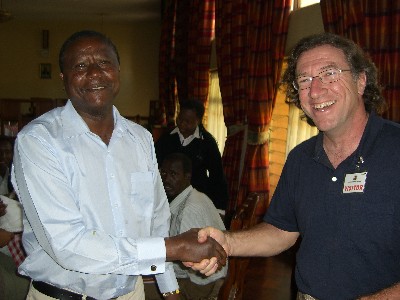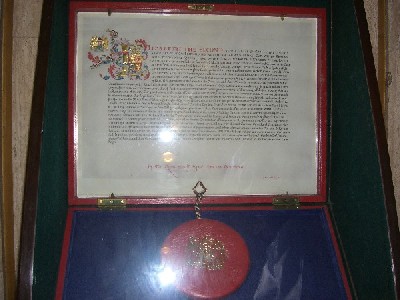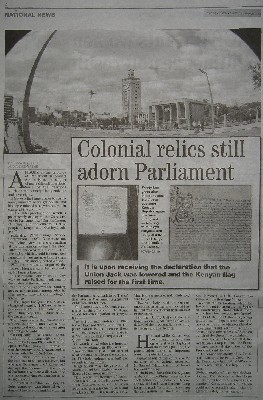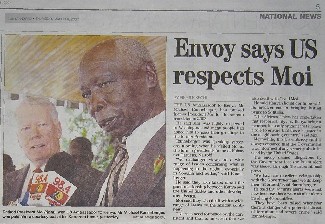
| FreeAfrica.Tripod.com/whoownskenya/
Home / Proclamation / Translations / About this Site |
| • | Background of this Site | |
| • | Other Sites on my Kenya Trip |
Background of this Site
by Marshall Burns
From the very beginning of my stay in Kenya in early 2007, I heard stories of unfair treatment by foreign economic interests that make Kenyans feel like they still live under a colonial power. From the 100,000 acres of prime farmland still owned and operated by a member of the British aristocracy, to the slave-like wages and working conditions on Del Monte’s pineapple plantations, to the shadowy financial details of the mining and exportation of titanium and soda ash, I kept getting hints that the “independence” this country acquired in 1963 was something short of real freedom for its people to live and prosper on their own resources.

| |
|
Meeting with MP Moffat Maitha at the Kenya Parliament, February 9, 2007
|
In early February, I had an opportunity to have lunch with Moffat Maitha, the member of parliament for the district of Kangundo, a sprawling rural community to the east of Nairobi. On entering the Parliament Building, I was taken aback by the large British-style coat of arms high on the wall overlooking the lobby. I wondered why people here wouldn’t want to rid themselves of such symbols of their former enslavement. But that was nothing compared to what I found on my way out.
As I was leaving the lunch, I noticed a glass case on one side of the lobby of the building. Looking inside, I saw a proclamation from Queen Elizabeth II. The language was the usual royal mumbo-jumbo, but it seemed to have something to do with the authority of the parliament to govern the country. I was astounded. Could it really be that the government of this African nation takes its authority from the Europeans who sacked and pillaged it for sixty years, murdered its people, and left it in ruins for the surviving natives to rebuild?

| |
|
Proclamation of Queen Elizabeth II establishing authority of the Kenyan Parliament, December 6, 1963 (Enlarge.)
|
Without saying anything about my first impressions of the document, I asked my host if I could take a picture of it. Several weeks later, I sat down to analyze its full text. I was flabbergasted. It did indeed seem to create the authority of the parliament of Kenya. In the document, the queen of England, in her “royal we,” refers to the parliament as “Our Parliament of Kenya,” she refers to Kenyans as “Our People of Kenya” and “Our Loyal Subjects,” and she refers to what happened in 1963 not as independence, but as “the attainment by Kenya of fully responsible status within the Commonwealth.” Then, after granting her husband authority to open the parliament on her behalf, she wishes Kenya “continued prosperity and happiness.”
One might expect to find such a historic relic in a museum next to the bayonets and suits of armor. But there was nothing on the glass case or the wall next to it to indicate this was anything other than the official legal charter of the Kenyan Parliament.
That bit about “continued prosperity and happiness” really irked me. Was she supposed to be suggesting that what native Kenyans experienced before her proclamation was anything akin to prosperity and happiness? Or was she cursing the people of Kenya to, now that they had pushed her people out, continue to suffer the same lack of prosperity and happiness that had been imposed on them under colonial rule?
I couldn’t believe what I was reading. As I wrote in an e-mail to the friends I had made in Kenya up to that time, “One could forgive the queen of England for having the arrogance to think that she still owns you, but my question is why does the government of Kenya still allow that document to be displayed in the lobby of the Parliament Building without a disclaimer? Who really is in charge of this country?”

| |
|
Article in The Standard about the queen’s proclamation (Enlarge.)
|
I didn’t get any responses to my e-mail and I thought it was going to be just another disillusionment in my experience of Africa. But a week later, I got a call from Thadeus Mutisya, the man who had taken me to have lunch with Maitha. He asked if I had seen the Standard newspaper that day and told me I’d better get one. I happened to be in the small town of Kangundo at the time, which was sold out of Standards, so I took a bus about ten kilometers to Tala to find one. Inside was a nearly full-page story about the proclamation in the Parliament Building lobby, with my photographs of it and many of the comments from my e-mail quoted verbatim.
I don’t know how my e-mail made its way to reporters at the Standard, but they seem to have used it to raise a bit of a stir. The article said that just the day before, a senior government official had vowed to have the proclamation removed. “This is an act of oversight, which should be corrected immediately. We are now taking steps to reform parliament.” Another official put the significance of the proclamation’s presence in parliament more strongly, “This document is a small part of what we inherited from the colonialist. The independence was half and superficial.”
It was exciting to see my work spur action in the halls of government. I don’t think I’ve ever influenced the proceedings of a country before. But as I look more and more at the situation here, I see little chance of the action I’ve spurred making any difference. In fact, it could make things worse. The first official quoted in the article vowed to remove the proclamation as part of a series of changes underway in the operating procedures of the parliament. He did not say anything about changing the government structures and policies by which foreign economic interests continue to control the major resources of the country. This is what the second official was referring to as a superficial independence. As long as those structures and policies remain, it would be better if the proclamation were left hanging as full notice to the Kenyan people that they are not yet free. When the proclamation is taken down, an overt sign of oppression will disappear, making it harder for Kenyan activists to gain traction in demonstrating how the oppression of the colonial era continues.
The queen’s proclamation makes me think of a bank robber dropping his business card at the scene of the crime. I imagine the thief going back to the bank and taking the card from the hands of a detective who has just picked it up, saying, “Sorry, you don’t need to see that.” In response to the Standard article, the Kenya government is saying to its people, “Oh, sorry, you don’t need to see that anymore,” while it continues to stash the treasures of Kenya in foreign bank accounts.

| |
|
US ambassador praises Kenya’s dictator turned business tycoon (Enlarge.)
|
In a twisted stroke of irony, the facing page of the newspaper carried an article that demonstrates the collaboration of foreign powers in Africa with its domestic despots. The ambassador of the United States is shown visiting the home of former “president” Moi, bringing from Washington greetings and admiration for the man who ruled Kenya with an iron fist for 24 years. The article says the ambassador praised Moi for the smooth transition of power in 2002. Returning to the analogy of the bank robber, it is as if a career thief were praised by the chief of police for using his loot to set up a string of legitimate businesses, which is exactly what Moi has done.
So, who does own Kenya? This became, in a way, the underlying theme of my report on my experience of my visit here, called Disillusion and Hope on the Dark Continent. There, I review what I’ve learned here about atrocities of my people against Africa, about how the native culture led to Africans taking part in those atrocities, and about the situation today, where foreign countries and companies work with corrupt despots here (many of them “democratically” elected) to control the economies of Africa, enabling them to siphon off its resources while making a show of throwing bits of charity at it to look good.
So Queen Elizabeth is right. She does still own Kenya and the rest of Africa, in cahoots with the leaders of other industrial countries and companies and with its own corrupt rulers whom they support. Most Kenyans already know that, although they didn’t know there is still a proclamation from the queen in the Parliament Building to attest to it.
=====================================================
Version notes:
| • | 2007 03 31 S: Site posted | |
| • | 2007 04 02 M: Fixed spelling on this page, added these version notes | |
| • | 2009 06 12 F: Site was found to no longer exist, presumably meaning that it was removed at some time by GeoCities without notice to me. In checking it out, I found that GeoCities had recently announced it is shutting down its service. I therefore migrated this and the other associated sites to another free Web hosting service, Tripod. I also obfuscated the profanity in the vernacular translation in case the explicit profanity had been the reason GeoCities removed the site. |
This is one of several sites created during my two and a half months in Kenya, Africa in early 2007. The others are:
| • | Disillusion and Hope on the Dark Continent | |
| • | The Last Mau Mau — Kenya’s Freedom Heroes or Villains? by David Njagi | |
| • | Ogiek Land Cases and Historical Injustices — 1902 – 2004 by Towett Kimaiyo | |
| • | Mathare Youth Talent Organization — a site I created for them, currently maintained by MYTO themselves | |
| • | How to Make a Website for Free — Simple instructions for beginning activists |
The first item is a page within my personal website. The others have been set up in Tripod, instead of in my site, in order to give examples of what can be done with a low-tech site that can be created for free, as explained in the last site listed.
| FreeAfrica.Tripod.com/whoownskenya/
Home / Proclamation / Translations / About this Site |